Tag: PMP Digital Signal Processing
This article refers to the address: http://
Many observers and analysts have consistently stated that there will be only two technical topics in the field of electronic engineering and applications this year, one is wireless communication technology and the other is digital video technology.
Indeed, digital video technology has been the focus of attention in recent years, including digital video codec algorithms (such as: MPEG-4, H.264, VC-1), digital video interface terminals (such as: HDMI, DisplayPort), Digital video broadcasting technology (such as DVB-H, Qualcomm MediaFLO). Similarly, the video-related applications are also hot. Let’s take a look at the new generation of TV games (such as Nintendo Wii and Sony PS3), then look at Apple’s Apple TV released earlier this year, and then take a look at Google’s YouTube. There are also IPTV, HDTV, and home community security, video conferencing and video calls, to know how popular video applications are.
Similarly, after the digital walkman replaces the traditional CD (Compact Disc), the MD (Mini Disc), or even the digital recorder, it is also actively looking for the next wave of strong growth, and most likely The development route is the additional video function, including the display of static images, the playback of dynamic images, as well as static photography, dynamic video, etc., will become a new direction of enhancement, coupled with the continuous technology of handheld devices. Goblin enters the calculation, so this article will focus on PMP's in-flight technology and related technologies for more discussion and analysis. It is expected to benefit the operators and engineers who are trying to invest in PMP design.
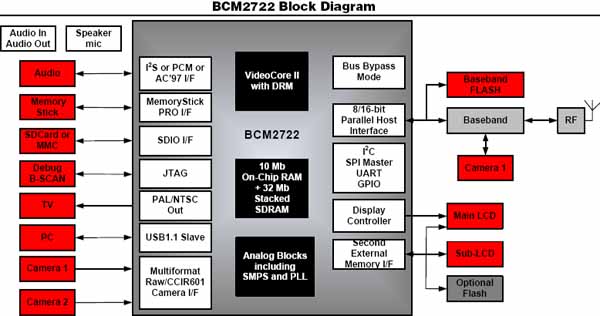
Caption: Broadcom's BCM2722 Mobile Multimedia Processor has the accelerated computing power of digital signal processors, and also supports DRM's digital rights management (content copy protection). Apple's iPod Video is the chip. To speed up the video playback operation, the picture shows the function block diagram of the BCM2722.
Video codec implementation
Video codec is the most critical part of PMP, but it is also the most common and non-conforming part of the current implementation. With the author's induction, there are many different implementation methods:
Designed and developed application chips for PMP requirements, mostly implemented in SoC mode. This can also be called ASIC or ASSP. Embedded processors (or controllers) or even embedded digital devices are used in ASIC/ASSP. Signal Processor (DSP), or hardware-line audio and video codec.
Using multimedia processors, such as Philips Semiconductor (now renamed NXP) TriMedia or Sigma Designs Media Processor, this type of processor mostly has VLIW architecture to accelerate multimedia video computing.
Using a dual-processor (or dual-core) design, in addition to using a general 32-bit microprocessor (or microcontroller), an additional digital signal processor, audio and video codec operation Part of it is the responsibility of the DSP, microprocessor / microcontroller (uP / uC) is responsible for general control work and general application execution, TI's OMAP box is the representative of this. (Note 1)
The same use of a general 32-bit microprocessor, microcontroller, but another collocation chip is a codec chip that has been hardware-coded for audio and video codec operations. This is generally called a CODEC chip, if only If you need the playback function, you only need to decode the chip that is calculated by the hardware. This is called "decoder chip, Decoder". If you want to record and record outside the playback, you must use the "codec chip, CODEC".
Only 32-bit microprocessors and microcontroller chips are used. All multimedia codec operations are implemented in software. After the PMP power is turned on, these calculation programs are loaded into the PMP system main memory, and then executed by the processor. Codec calculus in various formats.

Caption: Microsoft's Zune Digital Walkman is also equivalent to a portable media player. The Microsoft Zune locks the market competitor Apple Mac, Zune is clearly better than the iPod (fifth generation), mainly WiFi wireless function, Zune Allow users to share digital music and digital photos to friends via WiFi wirelessly, and still be managed by DRM mechanism after sharing. (Source:
Comparison of differences in implementation methods
There are no absolute advantages and disadvantages in the above five implementation methods, but the right and wrong choices are used at the right time. The advantage of choosing the first method is that it is the most cost-effective in mass production. The reason is that the chip has the highest efficiency integration. The off-chip parts have the lowest requirements for matching, and the power efficiency is also the best. Not only the part of the codec calculation is realized by hardware, but also the high level of integration can achieve centralized and consistent power management.
However, the shortcoming of this (first) approach is the lack of flexibility. Once there is a need to add or modify codec algorithms, or need to add other effects, or even correct the original power errors, the scope of the repair can also be The lowest, plus PMP is the mobile operation of the battery operation, at this stage is not easy to use FPGA, CPLD and other programmable logic devices to improve the flexibility of the hardware circuit design.
Therefore, unless it is a very large supply, or a long-term invariant supply, it will rarely be achieved with the least flexible and completely custom design, and this method must be compared with other methods during chip design and development. More attention to debugging, verification and other procedures, otherwise if there is a need to modify in the future and other methods can not be strengthened, the time, effort, cost, etc. of reopening the mask and re-launching will be quite high.
Followed by the second, third, fourth and other neutral practices, the flexibility of the three practices is higher than the first practice, and is now a more common practice. In this practical example, Apple's fifth-generation iPod (also known as iPod Video) uses the third method. The microprocessor part uses PortalPlayer's PP5021C-TDF Walkman main control chip (the core is 2 ARM7TDMI). ), and then with a Broadcom (Broadcom) BCM2722 chip, the BCM2722 chip is called a mobile multimedia processor, but in essence it is a digital signal processor. (Note 2)
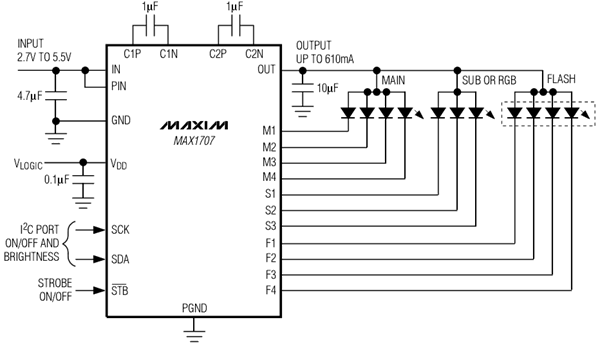
Caption: The digital walkman backlight can be driven by a simple series and parallel design. However, because PMP uses more white LEDs and pays attention to light uniformity, most of them need special white LED driver chips to drive. The picture shows MAXIM. White LED driver chip: MAX1707, its drive current can be up to 610mA, and can simultaneously drive 3 groups of LED applications in parallel. (Source: )
Let's look at another example. Microsoft's Zune uses Freescale's i.MX31L (core ARM1136) in the main control chip. The chip also integrates a hardware-based MPEG-4 encoder. In the fourth approach, the only difference is that the chips from two discrete packages are integrated into a single chip. However, Microsoft Zune is not entirely the fourth method. Perhaps the hardware function of the i.MX31L chip can be directly used in the encoding of MPEG-4 format, but other audio and video formats other than MPEG-4 can only be used purely. The way the software is implemented is the fifth approach.
As for the fifth method, it is exactly the two extremes with the first method. The disadvantage of the fifth method is that it consumes the most power, and in addition to power consumption, it usually requires a more efficient processor and a larger space. The system main memory, even to increase the battery's capacity (meaning that the volume and weight should be increased) can have the same continuous playback time as the first four modes, but the advantage is the highest flexibility, to add or modify any codec. The algorithm can be achieved by updating the firmware program, and it will not be used at the hardware level. Most of the hardware components are generally standard components (including the processor). The source and price of the hardware supply are also relatively high. elasticity.
monitor
For designers who have upgraded from digital music players to portable media players, the engineering skills of displays may have to undergo a change. In the past, digital walkmans could use Color STN, OLED, etc. as displays, but In the PMP field, I am afraid that both methods must be abandoned, and TFT LCD must be used.
In addition, the colorful backlight technology (using 7 different color LEDs) that can be sold in the digital music player is also not applicable in the PMP field (unless it provides the context effect of the electronic photo album), the LED can still be used. Backlight technology, but only white LEDs can be used, and it is very likely to consider and evaluate the use of backlight technologies such as EL and CCFL because of power saving or price factor. Therefore, the power supply design on the backlight driver is more complicated than LED.
Even with white LEDs, the display area will be much larger than in the past, so you need to use the components of the light guide (3.5 inch 7 inch), and use more design in terms of light uniformity.
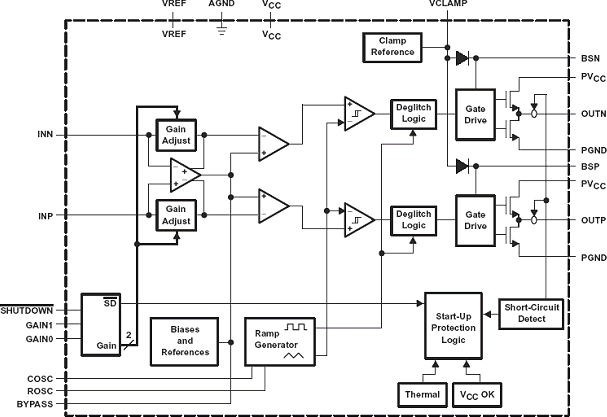
Caption: Because handheld devices such as PMP are quite power-saving, most of the audio power amplification methods that can be used are Class D amplification. In addition to the high power efficiency, Class D amplification is more compact than other amplification counts. The picture shows a 20W mono Class D amplifier from Texas Instruments (TI): an internal functional block diagram of the TPA3001D1. (Source: )
It is worth noting that backlights and processors, micro-hard disks, etc. are the main power-consuming components in PMP devices, so it is necessary to pay special attention to power-saving design. In the automatic power-saving mechanism, it must be able to be in a few minutes (preset If the user has no operation or no content playback (or the content of the screen is changed), the backlight should be turned off to save power.
Storage medium
In the past, PMP's storage media were Micro Drives. Micro-disks refer to hard disks with disc diameters below 1.8 inches. The main players in this area are Toshiba and Hitachi (more correctly, HGST), Seagate, Cornice, and Magicstor, in addition to 1.8 inches, are mainly 1 inch, 0.85 inch and other specifications.
The main consideration for PMP's use of micro-disks is the price-to-capacity ratio. If a VCD film requires 1.3GB (two 650MB), a DVD movie requires 4.7GB, and the number of reasonable external videos is about 610 (Note 3) ), so little is said to require 7.8GB47GB capacity, if these capacities are to be achieved with flash memory, the price of a PMP will be too high for consumers to accept, so the micro-disk must be used.
Caption: PMP storage media is mostly micro-hard disk, although the price of (NAND-type) flash memory is rapidly falling, the initial PMP and the junior high-end digital walkman have been switched to flash memory, but the micro-hard disk is in the middle There is still a price-to-capacity advantage in the PMP and high-end digital Walkman markets. The picture shows Hitachi's mini hard drive. (Source: )
However, the situation is gradually changing. In terms of USB flash drives, the 4GB capacity has dropped to NT$800,900, and the popularity of new video compression algorithms such as MPEG-4 and H.264 can be "crazy." To describe, a 60-minute film can be stored in a space of about 300MB and the picture quality can still be maintained at a certain level (Note 4).
Due to the interaction of the two effects, the minimum reasonable use capacity acceptable to the PMP can be corrected. The reasonable and practical minimum acceptable capacity and price are adjusted. The PMP equipped with 8GB 12GB (NAND) flash memory can be used as " The attitude of the entry-level model entered the market, rather than having to respect the mini-disk in the past.
Conclusion: Finally, other related technologies of PMP are gradually strengthening the evolution, such as faster charging efficiency (the more energy is charged in the shorter time), more extended applications (document reading, browsing the web), and more Accurate remaining battery display (from ADC measurement to Coulomb battery counting), more online methods (USB sync, USB street, wireless), these developments must also be noted.
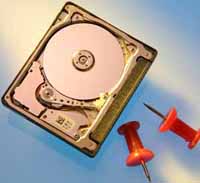
Caption: From a certain perspective, Sony's Mylo (My Life Online) is a slide-style PMP that combines more application and communication capabilities, but Mylo only has 1GB built-in fast. Flash memory is very tight in terms of video playback applications, but Mylo still offers a memory card slot to expand storage capacity.
Dmx Cable is customized LED Accessories to meet different led lighing project requirements, we can make Xlr Cable , xlr to xlr able, 3 Pin Dmx Cable, 5 pin DMX Cable. And the length is customized as well. The DMX cable can made by black pvc cable, white pvc cable, black rubber wire, and net wire, even the 18# color wire for indoor dmx signal transfer to get a economic solution.
Photo show of DMX Cable:
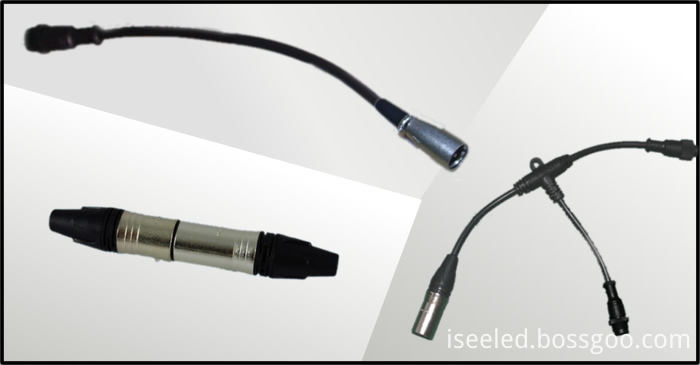
DMX Cable
Dmx Cable,Xlr Cable,Xlr To Xlr Cable,3 Pin Dmx Cable
Shenzhen Iseeled Technology Co., Ltd. , https://www.iseeledlight.com